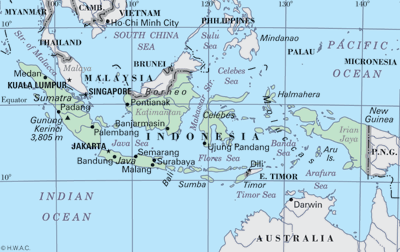|
THE REPUBLIC OF INDONESIA
 |
Indonesia is the largest archipelago in the world with 17,508
islands which consists of five major islands (Sumatra, Java,
Kalimantan /Southern part of Borneo, Sulawesi and Irian Jaya
/Western of New Guinea) and about 30 smaller islands serving as
home to the majority of the population. Approximately 300 ethnic
groups live on these islands, speaking an estimated 503
different languages and dialects.
The archipelago is located in South East Asia Region, stretching
out along the equator for over 3,200 miles on a crossroads
between two oceans, the Pacific and the Indian, and bridges two
continents, Asia and Australia, spans distance roughly
equivalent to that between San Francisco, CA and Boston,MA. The
Indonesian sea area is about 7.9 million sq. km (including an
exclusive economic zone) and constitutes 81% of the total area
of the country, four times greater than its land area, which is
about 1.9 million sq. km. The land area is generally covered by
thick tropical rainforest, where fertile soils are continuing
sly replenished by volcanic eruptions like those on the island
of Java. The country is predominantly mountainous with some 400
volcanoes, of which 100 are active.
HISTORY
Marco Polo, who came in 1292 to Indonesia was the first European
to visit this Archipelago. In 1511, after having conquered
Malacca on the Malay Peninsula, the Portuguese, in search of
spices, entered Indonesia for the first time. The Portuguese and
the Spaniards had later scored a strong grip on the eastern part
of Indonesia, the Moluccas. In 1602 the Dutch started colonizing
the archipelago and since then Indonesia was under Dutch rule
for almost 350 years. When the Second World War broke out in
Europe, which was extended to the Pacific War, the Japanese
occupied the Dutch East Indies as of March 1942 after the
surrender of the Dutch colonial army following the fall of
Hongkong, Manila and Singapore. On the first of April 1945,
American landed in Okinawa and further on 6th and 9th August
1945 the Allies dropped atomic bombs at two Japanese cities,
Hiroshima and Nagasaki, whereupon the Japanese surrendered to
the Allies on August 14th, 1945. This provided the opportunity
for the Indonesian people to proclaim their independence on
August 17th, 1945, through their national leaders Soekarno and
Mohammad Hatta, 3 days after the total surrender of the Japanese
to the Allies.
FOREIGN POLICY
Since its inception, the Republic of Indonesia has striven to
maintain an *active and independent* foreign policy. It espouses
a non-aligned position by pursuing constructive, responsible
relations with all nations. The policy is independent because
Indonesia does not side with world powers. As a matter of
principle, doing so would be incompatible with the country*s
national philosophy and identity as implied in Pancasila. The
foreign policy is active to the extent that Indonesia does not
maintain a passive or reactive stand on international issues but
seeks active participation in their settlement. In other words,
Indonesia*s independent and active policy is not a neutral
policy, but it is one that does not align Indonesia with the
super powers nor does it bind the country to any military pact.
Essentially, it is a policy designed to serve the national
interest while simultaneously allowing Indonesia to cooperate
with other nations to abolish colonialism and imperialism in all
their forms and manifestations for the sake of world peace and
social justice. This explains why Indonesia was one of the
founding members of the Non-Aligned Movement (NAM).
|